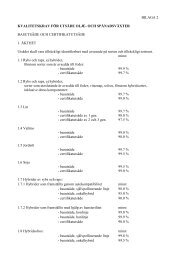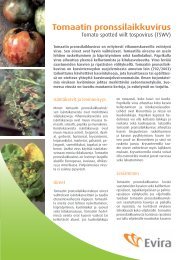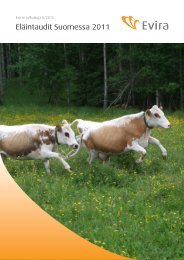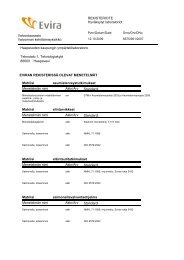Genetic characteristics of field and attenuated rabies viruses ... - Evira
Genetic characteristics of field and attenuated rabies viruses ... - Evira
Genetic characteristics of field and attenuated rabies viruses ... - Evira
You also want an ePaper? Increase the reach of your titles
YUMPU automatically turns print PDFs into web optimized ePapers that Google loves.
This method can be used for assessing the efficacy <strong>of</strong> oral fox vaccination campaigns<br />
<strong>and</strong> it was demonstrated that by using commercial ready-to-use microplates sensitized<br />
with <strong>rabies</strong> virus glycoprotein, a simple <strong>and</strong> rapid ELISA technique enables the obtaining<br />
<strong>of</strong> a <strong>rabies</strong> antibody quantization in <strong>field</strong> fox serum samples (Mebatsion et al., 1989;<br />
Esterhuysen et al., 1995; Cliquet et al., 2000, 2003, 2004, 2007; Servat et al., 2007).<br />
The latex agglutination test is also used to detect <strong>rabies</strong>-specific antibodies. Latex<br />
beads are sensitized by coating them with purified <strong>rabies</strong> glycoprotein to detect antiglycoprotein<br />
antibodies in serum samples. The visible agglutination is observed in the<br />
positive sera with a titer ≥ 2 IU/ml within 3–5 min after mixing, while serum samples<br />
containing less than 2 IU/ml do not agglutinate (Madhusudana <strong>and</strong> Saraswati, 2003).<br />
1.5. Rabies epidemiology<br />
1.5.1. Rabies situation world-wide<br />
Rabies is widely distributed throughout the world <strong>and</strong> is present in all continents<br />
except Australia, where only bat Lyssavirus has been found, <strong>and</strong> in Antarctica.<br />
Worldwide, it has been estimated that approximately 55000 persons die annually due to<br />
<strong>rabies</strong>; 99% <strong>of</strong> human <strong>rabies</strong> deaths have occurred in the developing countries. The total<br />
global expenditure on <strong>rabies</strong> prevention is well over US$ 1 billion annually (Warrel et al.,<br />
1995; WHO Expert Consultation on Rabies, 2005).<br />
Different animal species can be responsible for viral circulation <strong>and</strong> <strong>rabies</strong><br />
transmission in different continents <strong>and</strong> countries. Canids have been determined to be<br />
the main hosts <strong>of</strong> the <strong>rabies</strong> virus in Africa; in most cases they are also responsible for<br />
the transmission <strong>of</strong> the virus to humans. In addition to canids (domestic <strong>and</strong> wild dogs,<br />
jackals, <strong>and</strong> wolves), mongooses, <strong>and</strong> bats are involved in <strong>rabies</strong> epidemics, as occurs in<br />
Africa (Adeiga et al., 1996; Bingham, 2005). Dogs are also the primary reservoir for<br />
<strong>rabies</strong> in Thail<strong>and</strong> (Tepsumethanon et al., 2005). In the USA, several species are<br />
involved in <strong>rabies</strong> epidemics but the main reservoirs are raccoons <strong>and</strong> skunks (Krebs et<br />
al., 2003). An epizootic <strong>of</strong> raccoon <strong>rabies</strong>, begun in the USA in the late 1970s, <strong>and</strong><br />
developed into one <strong>of</strong> the largest <strong>and</strong> most extensive in the history <strong>of</strong> wildlife <strong>rabies</strong><br />
(Childs et al., 2000). Rabies has been detected in rodents <strong>and</strong> lagomorphs, mostly in<br />
woodchucks (Childs et al., 1997) <strong>and</strong> also in arctic foxes (Ballard et al., 2001). In<br />
addition, bats are sometimes responsible for the transmission <strong>of</strong> <strong>rabies</strong> to humans (Miah,<br />
2005).<br />
21

















